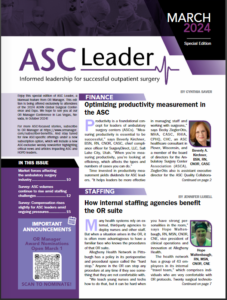
 Subscriber Content New quality measures, tight deadline mark CMS payment rule for ASCs
Subscriber Content New quality measures, tight deadline mark CMS payment rule for ASCs
It sounds like déjà vu all over again, as Yogi Berra used to say. That is likely to be the first reaction of many ambulatory surgery center (ASC) administrators to the Calendar Year 2014 Ambulatory Surgical Center Payment Proposed Rule. Pay formula unchanged Medicare payment updates would continue at…
 Subscriber Content Survey finds continued economic stress for ASCs
Subscriber Content Survey finds continued economic stress for ASCs
Although economic difficulties have started to ease in some areas of the US, many ambulatory surgery centers (ASCs) are still feeling the pinch, according to the 23rd annual OR Manager Salary/Career Survey. More than one-fourth (28%) of respondents say economic conditions have caused financial difficulties for ASCs primarily because of…
 Subscriber Content Careful screening and scrutiny needed to select ambulatory surgery patients
Subscriber Content Careful screening and scrutiny needed to select ambulatory surgery patients
The patient, an elderly woman, arrived at Red Rocks Surgery Center in Golden, Colorado, for an ophthalmology procedure. A paraplegic, she was using a scooter chair. Administrator Jane Klinglesmith, BS, RN, CNOR, watched her checking in at the admissions desk and noticed she was on dialysis. As she approached, Klinglesmith…
 Subscriber Content Follow protocols when using medications from compounding pharmacies
Subscriber Content Follow protocols when using medications from compounding pharmacies
Compounding pharmacies have long been valued for their ability to tailor prescription drugs for specific patients. More recently, they have helped conserve scarce drugs by redistributing them from larger to smaller single-use vials. For an ambulatory surgery center (ASC) that is not associated with a hospital and therefore has no…
 Subscriber Content ASC executives to meet with lawmakers
Subscriber Content ASC executives to meet with lawmakers
The Ambulatory Surgery Center Association (ASCA) annually asks members to participate in a “fly-in” to meet with members of Congress to raise awareness about the implications of health care policies. As ASCA vice president of government relations Steve Miller notes, there is nothing like hearing directly from a constituent to…
 Subscriber Content New CMS guidelines suggest changes in advance directive policies
Subscriber Content New CMS guidelines suggest changes in advance directive policies
Ambulatory surgery patients who become incapacitated should have their wishes for care honored, the Centers for Medicare and Medicaid Services (CMS) stresses in its new guidelines. Previously, the guidelines permitted an ambulatory surgery center (ASC), for reasons of conscience or policy, to refuse to honor advance directives calling for cessation…
 Subscriber Content ASCs must prepare to meet latest CMS infection control expectations
Subscriber Content ASCs must prepare to meet latest CMS infection control expectations
A perennial concern associated with surgery is avoidance of infection. As science reveals new risks and remedies, protocols change and so do regulations. To monitor infection control at ambulatory surgery centers (ASCs), surveyors use a 15-page worksheet from the Centers for Medicare and Medicaid Services (CMS). The ASC Infection Control…
 Subscriber Content Risk assessment helps prevent falls in ACS patients
Subscriber Content Risk assessment helps prevent falls in ACS patients
Anyone undergoing surgery is at heightened risk of falling, especially during recovery from sedation, and for the most vulnerable patients, a fall can be disabling or even deadly. Falls are among the adverse events monitored by the Centers for Medicare and Medicaid Services and state surveyors. The science of assessing…
 Subscriber Content Minnesota's adverse event reporting system has led to patient safety improvements
Subscriber Content Minnesota's adverse event reporting system has led to patient safety improvements
The number of patient falls, wrong-site procedures, and suicides increased slightly in Minnesota during 2012, but pressure ulcers, medication errors, and objects left in patients decreased, according to a recent study of the state’s hospitals and surgery centers. The “Adverse Health Events in Minnesota 2012 Public Report,” released in January…
 Subscriber Content Escorts essential for ensuring postop patient safety
Subscriber Content Escorts essential for ensuring postop patient safety
Before any elective surgery, patients are expected to arrange for an escort who will take responsibility for them at discharge—someone who will drive them home and possibly care for them as they recover from the effects of anesthesia. Despite a strict policy that patients must have a “responsible adult escort,”…


